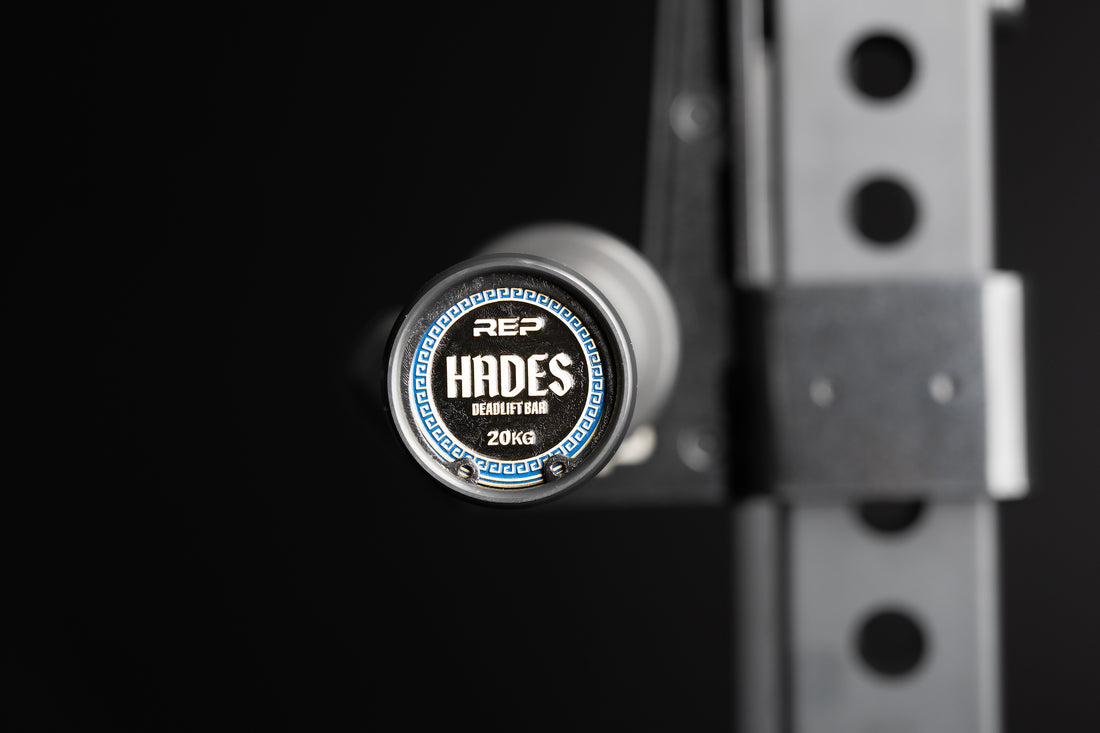
She's the thinner, taller, rougher cousin of a regular barbell, and sometimes she can be misunderstood. At first impression, she’s not for everyone; she comes off as pretty aggressive. But spend some time with her, and she’ll grow on you. You’ll begin to love her and wonder how you ever lived without her.
She’s Hades. Not the god of the dead. The god of the deadlift.
Here’s a closer look at the deadlift bar and why she can bring life to your lifts.
What is a Deadlift Bar?
A deadlift bar is a specialty barbell designed just for deadlifts. Compared to a power bar (or stiff bar), deadlift bars are longer, thinner, with more bend, and have more aggressive knurling – but no center knurling. You can also quickly identify a deadlift bar from a stiff bar because a deadlift bar has a longer sleeve lip.
REP’s deadlift bar features aggressive, mountain-style knurling to provide maximum grip support. The thinner shaft (27mm) and longer total length (7.9’) allows for more flex and whip. All measurements of the Hades bar adhere to powerlifting standards for associations that use a deadlift bar. Knurl markings help with proper hand placement.
The Hades also boasts a 15.75” loadable sleeve length, longer than most other deadlift bars, which means space for more weight plates on the bar. This is nice if you don’t have thin, calibrated plates at home and you are stacking plates on plates on plates. This bar maxes out at 1,500lbs, so not even Hafthor Bjornsson can tap its limits (yet).
The Hades is steel and offered in a sleek black Cerakote shaft with durable, smooth Duracoat™ sleeves. The bar is topped off with premium metal endcaps featuring unique designs and laser etchings of the barbell name and weight on the inside of the sleeves.
How Much Does a Deadlift Bar Weigh?
A standard deadlift bar typically weighs 20kg (about 44lbs). While there are specialized deadlift bars that may vary slightly in weight, but the most common deadlift bar used in competitions and gyms is 20kg.
What are the Benefits of a Deadlift Bar?

The biggest selling point is the earlier bar bend allows the lifter to gain momentum and speed before the weight leaves the ground. This can especially benefit sumo pulls and potentially contribute to heavier lifts. Breaking the floor is the hardest part of the deadlift for most lifters. Once you get the bar moving, many lifters can grind out the rest.
Some lifters also like the deep knurl that provides max grip assistance (grip is one of the first failure points on a deadlift). Lifters with smaller hands will also appreciate the narrower width. And since the shaft and sleeve lip are wider apart, sumo pullers can get a wider stance with a deadlift bar without risking the plates crushing their toes.
Do I Need a Deadlift Bar?
If you compete in an association (such as the USPA, IPL, or WRPF) that uses a deadlift bar in comp, you can benefit from training on the same style of bar. A pull on a deadlift bar feels quite different than on a stiff bar, and training on one type of bar and competing on a different bar can throw you off when the judges are watching. Plus, your attempt selection might be off, as many lifters can pull more on a deadlift bar.
Even if you don’t compete, many lifters just enjoy the feel of this barbell.
If you compete in a federation (such as USAPL) that uses a stiff bar for deadlifts and you want to train on a similar bar that has the most aggressive knurling, you may like the Double Black Diamond Power Bar.
Can I Use a Deadlift Bar for Other Lifts?
You can do whatever you want; we’re not your mom. But heavy squatting with a deadlift bar could be the real nightmare of the underworld, with no center knurling and the unstable whipping of the weights as you try to balance them on your back. Same goes for benching or an overhead press. Not sure why you’d want to use a deadlift bar for non-deadlifts. So yeah, maybe don’t. Your mom told us to tell you not to.
similar to this

NEWSLETTER SIGNUP
Product launch information, promotions, blogs, and REP news.







